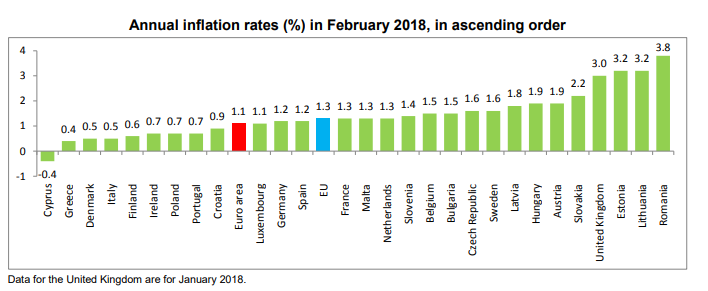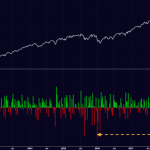Today, we received inflation data from the European Union. The data showed that inflation grew less than what analysts were expecting. The data from Eurostat showed that inflation grew by 1.1%. This was down from the analysts’ forecast of 1.3%. A year ago, this inflation data was at 2.0%.
The Year on Year core inflation remained unchanged at 1.0%, while the MoM core inflation was in line with the analysts’ forecast of 0.2%.
Among the EU countries, the lowest inflation rate was in Cyprus which had an inflation rate of -0.4%, Greece which had 0.4%, and Denmark which had inflation of 0.5%. The highest inflation rate was in Romania, Estonia, and Lithuania, which had an inflation rate of 3.8% and 3.2% respectively. The chart below shows the contribution of each country to the overall region’s inflation rate.

In the month, the biggest contributor to the inflation was from services which contributed 0.57 percentage point. This was followed by food, alcohol & tobacco, and energy which contributed 0.21% each. Non-energy industrial goods contributed 0.14%.
The general CPI went down to 1.1% from last month’s 1.2%. The decline was caused by low unprocessed food products which fell by 0.3% MoM and at an annualized rate of 0.9%. At the same time, energy prices declined by 0.3% on the month. On an annualized basis, the prices of energy products rose by 2.1%. Year to date, the benchmark Brent crude is up by about 3%.

The ECB watches closely the inflation numbers because its key mandate is to ensure price stability. An increase in inflation rate may lead the ECB to intervene by raising interest rates in a bid to limit the purchasing power. However, as seen above, the overall inflation for the region has remained comfortably below 2%, which is the target for the ECB.
Officials believe that the inflation will remain stable this year, partly because of a stronger euro. This will partly be due to higher energy prices and a stronger euro. Year to date, the euro has gained by more than 3% against the dollar.













Leave A Comment